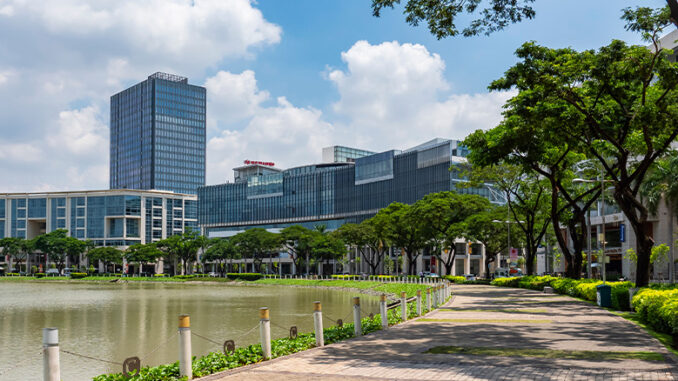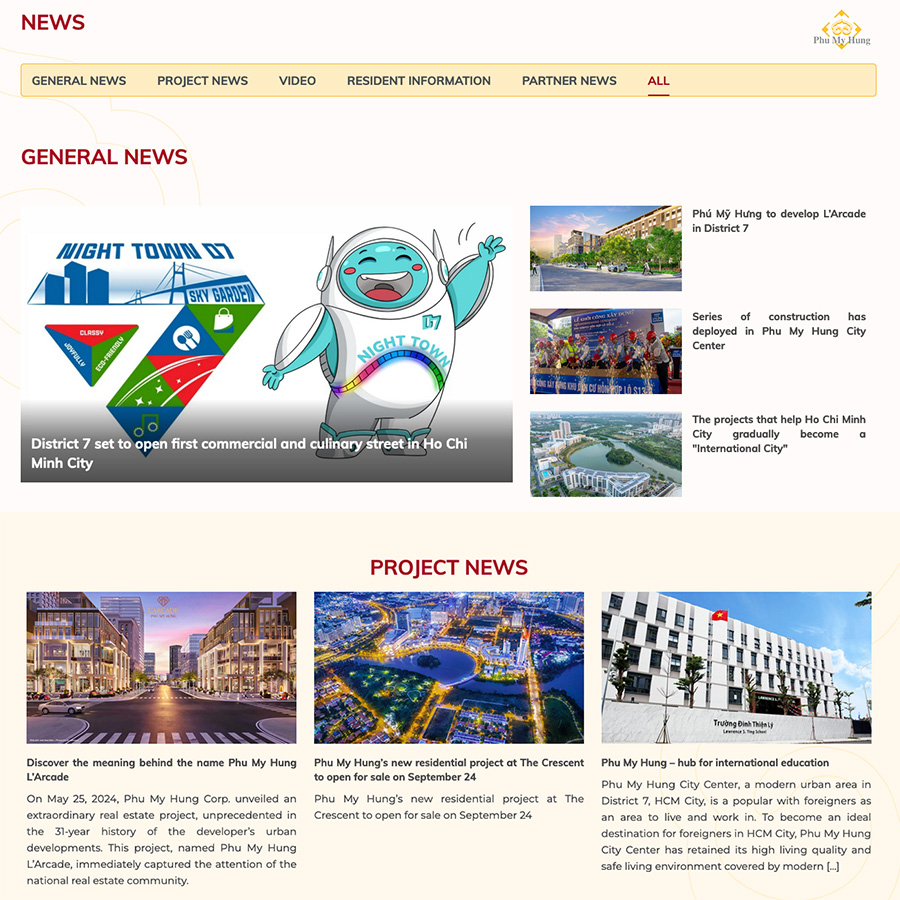
Vietnam is being impacted on by globalization. The new urban way of life has produced new challenges for policy makers. The HCM City administration has its own monitoring and surveys of problems and needs of people in District 7 (Phu My Hung township) and this article presents some of the main achievements and challenges pertaining to urban social management, taking into consideration the integration of foreigners.
Introduction
Built since the mid-1990s, the new township of Phu My Hung (belonging to District 7 of the Ho Chi Minh City metropolis) (henceforth PMH) has become a modern place for business, commerce, and finance. In this township, there are two wards called Tan Phong and Tan Phu. These are places of high-income residents living on 750 hectares of land. PMH Tan Phong ward has 3,184 foreigners (accounting for 50.4% of the total number of people living in the ward), Tan Phu ward has 2,988 foreigners (accounting for 30.3% of the total number of people living in the ward). More than 38% of the people living there are foreigners from South Korea, Japan, Taiwan and China, among others. (Ủy ban nhân dân Quận 7, 2022) and this is the largest concentration of foreigner residents in HCMC.
The rapid development of PMH is part of the rapid modernization and urbanization that HCMC has witnessed, and similar to HCMC, new problems on the cultural landscape present. Policy makers have had to monitor and pay attention to how to improve policy to deal with this rapid change and its problems. Government efforts have been directed at raising standards of urban management, but more important, to strengthen bonds between people and nature. (Vũ Thị Hồng Tứ, 2020). In fact, the City’s government sees the PMH Township as a model for reference to develop other urban areas.

Results of our monitoring and survey: Ways of life of residents in Phu My Hung
The PMH area has become an area of high-income residents, and expectedly, the standard of living is also high, and ways of life different from others. Such a group of people usually value privacy and may not want to participate in community activities. This way of life is nevertheless positive, organized, and involves healthy living requirements, while at the same time the modern society of today require people to be fully-occupied with their work and life arrangements. As result family and social relationships may have become less tightly-knit. People are also usually law-abiding and respect their neighbours and others. The level of good social management tended to depend on whether there is a management committee set up, and the level of social interaction in a place of residents from different nationalities may tend to have a low level of community engagement involving part or all of them.
Building a united and cultured community of residents
Residents of PMH in general do engage in activities of the resident groups, with more than 50% of PMH residents participating and most being Vietnamese. Such participation is encouraged by the Law on Grassroots Democracy (2022) and this encouragement is also extended to foreigners. In particular, all residents are invited to assist in crime prevention and building a cultured way of life. The government has built communal spaces (called Houses for Cultural Activities) and the local authorities and management committees have organized themed gatherings for all residents. These efforts are important bridges within communities, but they are also bridges among cultures and nationalities, and they promote mutual understanding. Exchange activities in the field of fitness and sports are held regularly in the neighborhood, attracting more than 50% of foreigners living in PMH to join clubs such as football, volleyball, table tennis, badminton, tennis, etc. In addition, every year local authorities and businesses together organize large-scale cultural, entertainment and sports events aimed at the participation of local people. These events are also aimed at getting foreigners in PMH to participate, so as to promote community and international cultural integration. Typically the activities are cultural, sports, and social goals oriented. Examples include: Spring Flower Fair, Trinh Cong Son Music Night, Responding to Earth Hour, Cycling for the environment, Lawrence S.Ting charity walk, running to support cancer patients Terry Fox, Southern Lotus Festival, and others. Other themes included the National Day Flag Raising Ceremony (2 September, first organized in 2009 at Sky Residences, and followed by other neighbourhoods in PMH. This ceremony has also caught the interests of foreigner residents. This participation shows patriotism among Vietnamese and respect from foreigners for Vietnam. In general, activities are regular and the local authority, businesses, and residents take an active interest in ensuring their success.

Overall results of work building cultured communities
In 2021, the Tan Phong ward 2,287 family units (80% of all family units in the ward) participated in a campaign to build Family of Culture. The idea is for each family and all its members to be mindful of rules and norms, and to live healthy family lives. One hundred percent of all participants received recognition as Family with Culture. In the Tan Phu ward, 2,170 families (100% of all family units in the ward) participated and 95.2% received similar recognition. Other than family units, the Tan Phu local authority also conducted a similar Family of Culture campaign among neighbourhood unit of each ward. In 2021 and 2022, all three neighborhoods units of Tan Phong ward met cultural family standards while Tan Phu ward had 1/6 such neighborhood units. (Ủy ban nhân dân Quận 7, 2022).
Our evaluation
We the local government in HCM City recognize that from the above results and more widely in this District 7, in particular PMH, community building activities are actively participated in, and foreigner families are also among the participants. The cultural values of Vietnam are maintained among Vietnamese and foreigners living in Phu My Hung have also not only gotten to know but also identified themselves with these values.
From our observations, the campaign to cultivate positive and appropriate ways of life in urban resident areas have been well-coordinated and well-attended. We note that the communication campaign and materials of the campaign were conveyed in different languages, and in general the social order and security of the PMH areas have been maintained. The positive results were also facilitated by the strong willingness of residents to participate and to abide by laws and regulations. The design of the PMH is also a semi-gated community: it is generally open to interaction with the world outside, but blocks and some areas have security gates that maintain privacy and security. This design has facilitated interaction among neighbourhoods of the PMH area. Cleaniness and orderliness of the neighbourhoods here are generally well-maintained as zoning and land use of the PMH have been effective in making sure that activities of the community are allotted indoor and outdoor spaces. Without such spaces, community activities would have been difficult to hold.
Aside from these positive results, we need to remind ourselves that some difficulties remain. New neighbourhoods would always take a certain amount of time before residents could gel together, since they are almost new to each other and to the area. In particular, foreigners are mostly tenants and their terms of lease are usually not long term or permanent. Therefore, communication and constant engagement with them have discontinuities and other difficulties, as residents come and go, and people busy with work may hardly talk to each other given that apartment doors are always closed. Second, among all residents the trend to keep house pets have resulted in problems of unleashed pets and their waste litter in public places. More activities need to be organized to encourage such residents to alter their habits in consideration for others. Here, foreigner residents may have a role to play in introducing good practices from their places of origin. This borrowing can be applied to many other areas of life as well.
Conclusion and experiences learned
The PMH area has welcome people from many countries and many nationalities. Among the foreigners and residents in general, educational standards, vocations, and income levels vary, and so is the case for their preferences. As such, every group of people, including Vietnamese, bring to the PMH area bring their own cultures and living habits into a common space of modern urban living. It is therefore expected that resolving differences and bridging dissimilarities, where necessary, would take a considerable amount of time. The reality shows that the hardware is easy to construct, but the social integration project that involves multiple cultures is more difficult by multiples. The positive phenomena that we see today have been the the result of 20 years of hardwork. Whether it is the hardware or the heartware, the human element takes the leading role in shaping the community according to appropriate humanistic values in the urban community. Our view is, the purchase of hardware is in essence the purchase of a way of life, a choice of a certain type of community with its accompanying habits and customs. It is a choice about who you want to neighbours to, and it is also a decision to embed families in an international environment. Effectiveness of communication campaigns in such an environment require the ability to utilize multiple languages to transmit guidelines, regulations of the neighbourhoods, and even laws of the state. At the same time, the country has social and mass organisations that have been tasked to organize community activities. While these organisations compete with each other for better results, they also work with each other to realise larger political and social objectives of the local government. The slogan of the government has been to “maximise the internal strengths of every resident, every family, every family lineage and extended family members, and every resident, in the spirit of not discriminating between Vietnamese or foreigners. This spirit has helped the PMH area to achieve ethnic acculturation and integration by Vietnam with other cultures outside Vietnam. This is why the PMH urban area deserves its rank as a Model Urban Area.
Nguyễn Minh Nhựt
People’s Council of the Ho Chi Minh City
Email: nhut227@gmail.com
Translated and edited by David Koh
Banner: HCM, District 7. Crescent in Phu My Hung urban area. Photo: vinh loc
References
Vũ Thị Hồng Tứ. (2020). Đời sống văn hóa của cư dân tại khu đô thị mới, Tạp chí Văn hóa – Nghệ thuật, số 432, tháng 6-2020.
Viện Văn hóa – Bộ Văn hóa. (1984). Xây dựng đời sống văn hóa ở cơ sở. Hà Nội.
Ủy ban nhân dân Quận 7. (2022). Báo cáo số 3951/BC-UBND ngày 12 tháng 10 năm 2022 của Ủy ban nhân dân Quận 7 về tình hình xây dựng đời sống văn hóa tại khu dân cư Quận 7.
Ủy ban nhân dân Quận Bình Thạnh. (2022). Báo cáo số 463/BC-UBND-BCĐ ngày 13 tháng 10 năm 2022 của Ủy ban nhân dân quận Bình Thạnh về tình hình xây dựng đời sống văn hóa tại các khu đô thị mới trên địa bàn quận Bình Thạnh năm 2022.
